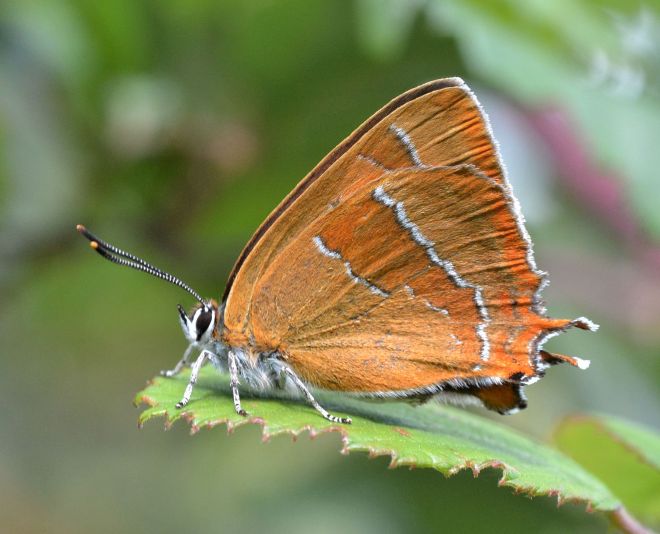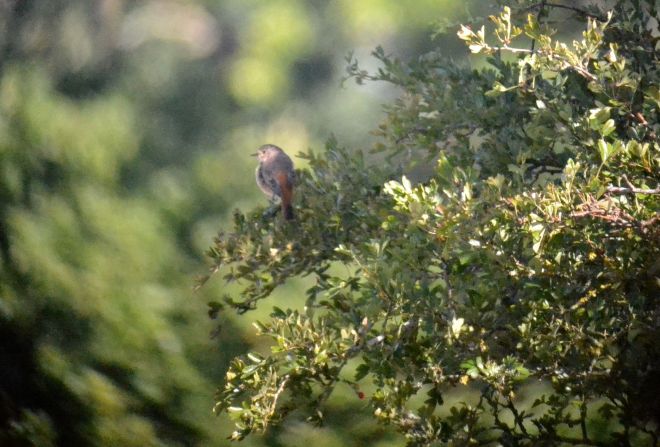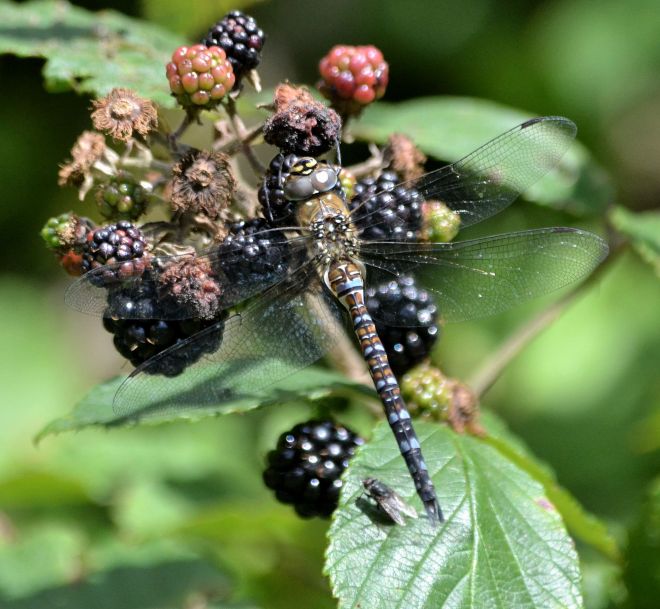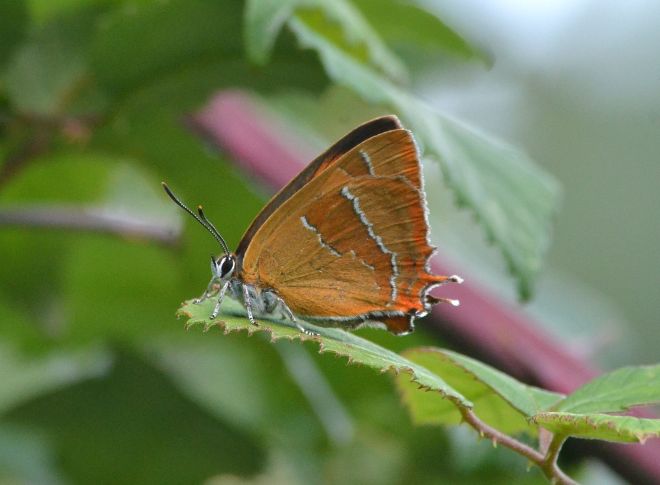Today offered a window in what has been more than three weeks of conveyor belt Atlantic weather since the previous insect post in this journal. My choice was to try to track down some Brown Hairstreak butterflies at a new and different location, and in the process hopefully photograph Southern and Migrant Hawker dragonflies that are also on the wing at present. When I visited BBOWT’s Rushbeds reserve in the first days of July (see here) I had noted some areas that looked like ideal habitat for Hairstreaks and resolved to check them out later in the season. So that was where I headed this morning.
The soggy second half of July and start to August has been good for my wildlife garden at home, that is currently under re-establishment, but not so for getting out and about. It must also have helped Brown Hairstreaks that having emerged early this year in common with other butterflies, will have suffered less of the harassment they always endure with the change in the weather. After all butterflies are quite capable of getting on with reproducing their species away from human gaze, whatever the conditions.

Mission accomplished – premium Brown Hairstreak
I started the day at Oxford’s Otmoor RSPB “home for nature” where the yearly Hairstreak bun fight has resumed in earnest during recent rain breaks. But that situation may also be of wider benefit if the destructive attentions of butterfly tourists can be concentrated at one welcoming site. My reason for going there was to see Common Redstart on land adjacent to the reserve these birds frequent at this time of year. I found two females and in making a complete hash of photographing them gained one of those images (below) that look more like a painting but to me are strangely pleasing.

Female Common Redstart in oils (or dodgy record shot?)
On waking to fair weather I had just wanted to get up and out and there was no point in going to my insect destination too early. In the event I lost time due to a road closure and HGVs not being able to pass one another on the diversion around it. So it was not until 11am that I arrived at the southern edge of Rushbeds Wood (SP672154). Here there is a lot of Blackthorn, the BH food plant and bramble banks; and the hedgerows were bursting with an abundance of autumn fruits. It didn’t take long to come across a first Migrant Hawker dragonfly in its immature colouring (pictured below).

Migrant Hawker (immature male)
This was one of the forms I most wanted to capture today. It is still early in this autumn hawker’s flight season and many of the insects being observed will be of this brown and mauve, grey-eyed appearance. In early July it had been the emergent Southern Hawker that were in their own immature colours, now today along this woodland edge I encountered several brightly patterned adults, both male and female (below).
Through all this I was careful not to trample habitat, only treading where other people had already trod, not moving around too much once on a subject and always trying to look where I was putting my feet. I would like to think of this as a best practice model. After walking in such a way as far as possible to the western edge of the reserve, I retraced my steps then continued to the east of the exit gate from the woods. This looked even better for Brown Hairstreak with huge, mature Ash towering above extensive stands of Blackthorn and a brambly under storey.
I was at this point joined by a Butterfly Conservation transect walker with whom I am acquainted. He confirmed this is indeed a site that is both managed and regularly monitored for BH, but neither of us saw one today. Of the butterflies that were on the wing the few remaining Silver-washed Fritillary (top left, below) were very worn, quite a contrast to their majesty in June and July. Meadow Brown and Gatekeeper were still active but the myriad Ringlet of mid-summer were all gone.
Some butterflies always seem to photograph well and others not. Green-veined White (bottom right, above) are definitely in the former category. This second brood individual shows bolder patterning than the paler insects seen in spring, and the rather striking veining with creamy yellow highlights and pale green eyes always seem to stand out from a suitably subtle backdrop. Common Blue rarely make a good top-wing picture, but the underwing shot (bottom left) was worth saving. The top right picture is the drab form of female Common Blue Damselfly, yes really and always an interesting variant to come across.
It was now early afternoon and I next walked the main ride through Rushbeds Wood without observing anything more of note. At the northern end of the reserve lies a wild flower meadow that is surrounded on three sides by Blackthorn hedges. In mid-summer this area teems with common grassland butterflies but by this time of year it has been mowed. As soon as I walked through the gate from the northern edge of the wood a small brown butterfly flew up from the grass at my feet into a hedge to one side. This looked promising and indeed I was connecting with a fresh female Brown Hairstreak.

Oh you beauty – female Brown Hairstreak
Almost at once the sun went in and a cool breeze blew up. As a result my butterfly kept stock still for some time just inches from my admiring gaze, glistening in all her pristine beauty. I changed to my macro lens, set my entry level Nikon to its freeze the action sports setting, then commenced upon the kind of peaceful communion and oneness with an insect in the field that I most crave. This is only possible when butterflying or dragonflying alone. If insects are not chased about, surrounded and jostled they will give of themselves freely in this way. I have enjoyed dozens of such encounters at the back of beyond in Portugal, Cyprus, Morocco, the south of France and elsewhere and today was just the latest such occasion.

And a little closer … but she doesn’t mind
It wasn’t going to get better but I still walked a quick circuit of the meadow without seeing any more Brown Hairstreak, before returning through the wood to my start point. This had been a most rewarding day out. I had encountered all my sought after wildlife whilst crossing paths with just one expert naturalist and two genial dog walkers. After rather too much recent rain whatever the benefit to my garden, it goes without saying that I returned home with spirit well and truly refreshed.






